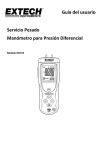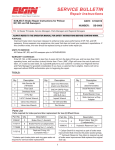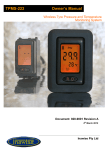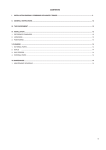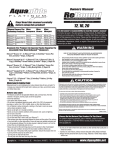Download AA VIGILANCE CONTROL TROUBLESHOOTING
Transcript
AA VIGILANCE CONTROL TROUBLESHOOTING The following is a list of some of the faults that could occur in the Vigilance Control System. Drawing Reference PL 11 Part 10 - Section 1.35 1. a) SYMPTOM Penalty Application With Audible Warning. Indicator hand in green band at time of application. PROBABLE CAUSE TEST REMEDY Faulty Indicator Operate Vigilance throughout its range noting operating pressures of the various valves and that the gauge movement is free. Check gauge against brake cylinder gauge (pressures stable) - should register 3-4 psi approx. less than brake cylinder pressure. Brake cylinder gauge should be tested against Standard test gauge. If defective, change gauge allowable gauge error 2psi Hand of gauge may be set if less than 5 psi in error. b) High timing volume pressure. Magnet valve (No.3) permanently energised or not exhausting. Check for blow of air from magnet valve exhaust port, if no blow turn off isolating switch to acknowledgment button, if blow is then present the trouble is electrical. Electrician to locate and rectify defect. c) Low timing volume pressure. Magnet valve (No.3) not energising. Make sure all switches in magnet valve circuit are correctly positioned. Depress magnet valve by hand, note if pressure rises, and that equipment functions correctly whilst magnet valve is manually operated. Electrician to locate and rectify defect. d) Trailing Unit (Audible warning on trailing unit). Suppression valve DC.25 (No.2) not seating. or Make a full independent brake application and energise magnet valve (No.3). If timing volume pressure increases continuously, suppression valve DC.25 (No.2) is not seating. Change DC.25 suppression valve (No.2). Double check valve type BC (No.6) sticking. Release brakes, close isolating cocks to both driver's brake valve pedestals, disconnect pipe from centre of double check valve (No.6), if no blow is present, check valve may be sticking or there is a piping defect. Test piping from drivers brake valve isolating cocks to the double check valve (No.6). Clean double check valve (No.6). Note: Trouble experienced whilst a trailing unit. or piping defective. or repair piping. Part 10 - Section 1.35 2. SYMPTOM Penalty Application Without Audible Warning a. High timing volume pressure, Independent brake applied. b. Indicator hand in green band. PROBABLE CAUSE TEST REMEDY Independent brake application pressure too high. Observe brake cylinder pressure, this pressure feeds into timing volume operating the valves in the vigilance if it becomes excessive. Pressure reducing valve may be set too high or defective (with A7 equipment) or the selflapping portion of the B7 independent brake set too high or defective. Reduce pressure change M3 pressure reducing valve or change B7 independent brake valve. Penalty valve DC.17 (No.10) not seating correctly. Check for blow of air from 1/16" dia relief port at connection of C.13 check valve (No.11) to vigilance valve unit casting. If blow make a full independent brake application, blow will stop if DC.17 (No.10) valve is leaking through. Penalty applications should not take place whilst equipment is suppressed either by over 25 psi brake cylinder pressure or by both driver's brake valve isolating cocks being closed. If they do test for Symptom 1(d). Change DC.17 valve. Part 10 - Section 1.35 3. SYMPTOM Penalty Application Cannot Be Released PROBABLE CAUSE Emergency Application Valve (No.16) off its seat. TEST Blow of air at Emergency Application Valve (No.16) exhaust will be evident. Clean emergency application valve, if trouble still persists check for blow at the exhaust of Snap Action Penalty Valve No.13. REMEDY Clean valve and examine 1/16" bypass port, in Emergency Application Valve. If a blow, reduce brake pipe pressure and note there is an exhaust from the brake pipe reset valve (No.15), if so the snap action penalty valve is defective. Change snap action penalty valve. If no blow from exhaust of brake pipe reset valve, with brake pipe reduced below 25 psi, this valve is defective. Change DC.25 brake pipe reset valve. Locking volume leakage. Fully apply independent brake and test with soap, locking volume piping from C.13 check valves (No.11 and 12) to snap acting penalty valve (No.13) and brake pipe reset valve (No.15), not forgetting the exhaust port of this valve (brake pressure normal). Also check exhaust port at fitting between check valve (No.11) and unit casting. Repair piping or clean check valve. Snap Action Penalty Valve (No.13) defective. Test as above and at leakage exhaust port of snap action penalty valve. Change snap action penalty valve. Check valve C.13(No.12 not seating correctly). Reduce timing volume pressure to operating pressure of DC.17 penalty application valve (No.10), if timing volume pressure then rises and falls about 2 psi check valve is defective. Clean rubber valve or renew if badly marked. OR Snap Action Penalty Valve (No.13) defective. OR Brake pipe reset valve defective. 4. Penalty Application Resets Without the Brake Pipe reduced below 25 psi Part 10 - Section 1.35 5. 6. SYMPTOM Audible Warning Unobtainable (Gauge) Registered Correctly a. High and low timing pressure. Audible Warning Continually Blowing a. Brakes released and indicator hand in green band. PROBABLE CAUSE TEST REMEDY Whistle faulty. Allow indicator to enter red band and note blow of air at whistle Change whistle. Defective piping to audible warning. Allow indicator to enter red band, loosen connection on top of vigilance unit casting and note blow of air, tighten connection and test audible warning piping. Repair pipework. Audible Warning Valve D.70 (No.8) defective. Allow indicator to enter red band to high range, loosen connection on top of vigilance unit casting and if no blow is present D.70 valve (No.8) defective. Change D.70 valve. Choke (C) blocked or DC.25 Audible warning valve (No.9) defective. Allow indicator to enter red band in low range, loosen connection on top of vigilance unit casting and if no blow present remove DC.25 (No.9) audible warning valve and examine choke, if clear DC.25 is defective Clear choke or change DC.25 valve. Audible warning valves D.70 (No.8) or DC.25 (No.9) not seating correctly. Change DC.25 audible warning valve (No.9), if none available in store change with the brake pipe reset valve (No.15). If trouble still exists D.70 valve(No.8) is defective. If trouble is rectified the D.25 valve now on the brake pipe reset will have a blow of air at the exhaust port and it should be changed. Change defective valve. Part 10 - Section 1.35 6. SYMPTOM Audible Warning Continually Blowing b. With independent brake applied. 7. Brake Cylinder Pressure Not Suppressing Equipment 8. Timing volume pressure a. Falls rapidly when brakes released, magnet valve deenergised. PROBABLE CAUSE TEST REMEDY Independent Brake pressure too low. A full independent brake application should be 45 psi in the brake cylinders, if this is below 25 psi it will not seat the suppression valve (No.2) allowing the whistle to sound. If brake cylinder pressure is below 17 psi a penalty application will occur. Rectify defect in brake equipment. Bogie brake isolating cock closed or piping defective. Observe brake cylinder gauge for the bogie under the No 1 cab, if no pressure registered bogie isolation cock is closed, or piping defective. Open isolation cock or repair piping. C.13 check valve (No.5) defective. Make a full independent brake application and release noting that timing volume pressure drops with brake cylinder pressure. Clean rubber valve, renew if badly marked. Check valve in check valve choke (No.24) defective. Energise magnet valve and note exhaust from same, exhaust will be excessive if check valve defective. Clean rubber valve renew if valve badly marked. Piping defective (pipe leakage test). Charge timing volume to 65 psi or as high as possible then apply independent brake and with magnet valve energised note leakage. Repair pipework or clean rubber valve. AA System b. Slow in charging or will not charge.






